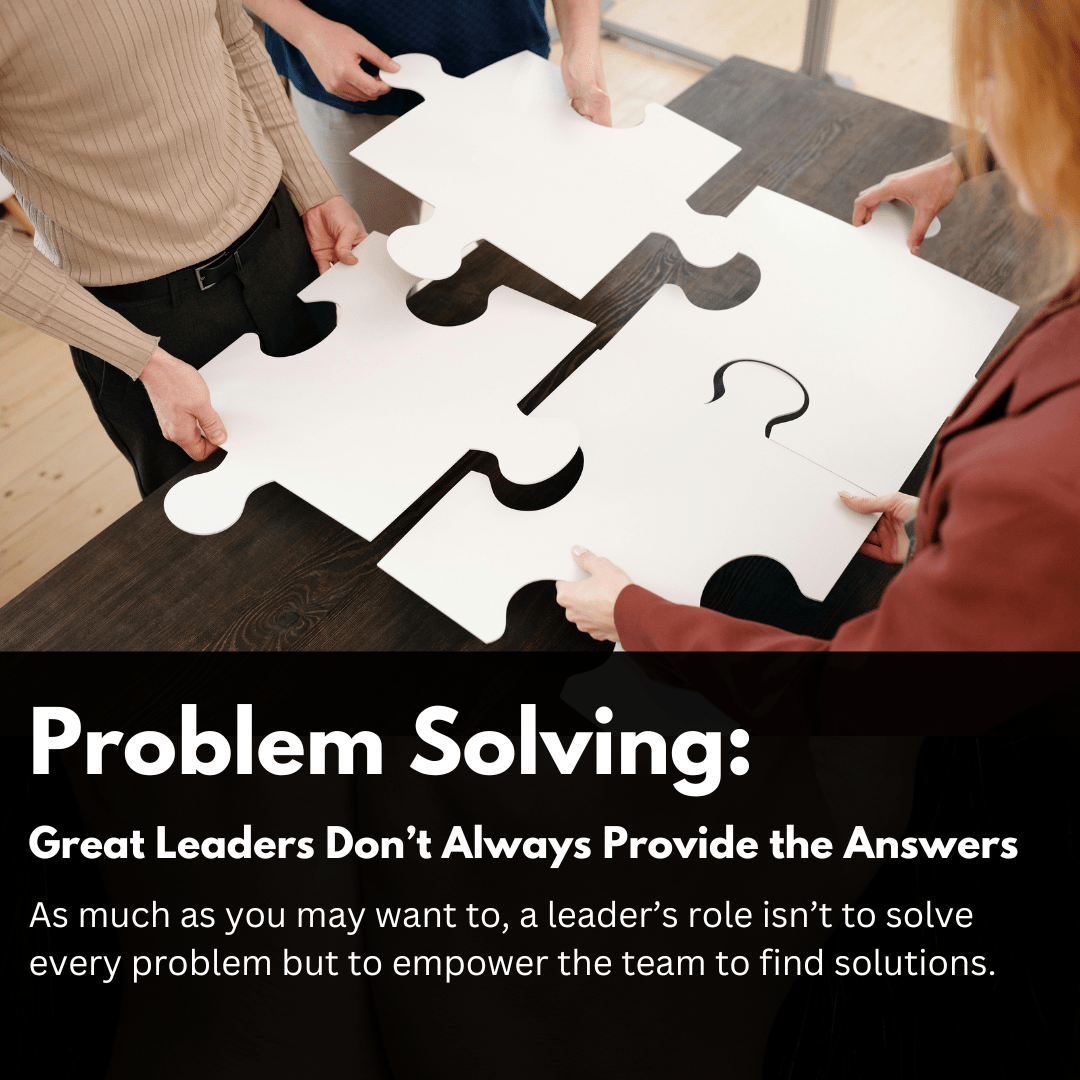One of the most common misconceptions about leadership is that it requires having all the answers.
Many new leaders fall into this trap, believing their credibility depends on their problem solving ability. Their ability to solve every problem, provide every solution, and steer every decision.
It’s an understandable mistake, after all, leaders are often seen as the go-to experts.
However, the most effective leaders recognise that their true responsibility is not to solve every challenge themselves but to build a team capable of thinking critically and solving problems independently.
When leaders take on the role of “chief problem-solver,” they unintentionally create dependency.

Team members begin to rely on them for every decision, waiting for direction rather than thinking for themselves. Over time, this stifles creativity, slows progress, and places an unsustainable burden on the leader.
In contrast, leaders who foster a problem solving mindset within their teams drive innovation, agility, and long-term success. These leaders give their team the tools, the confidence and the power to solve problems for themselves.
The Hidden Risks of Always Providing the Answers
When leaders position themselves as the sole source of solutions, they inadvertently create a cycle of dependency that leads to several unintended consequences:
- Slower decision-making – Teams hesitate to act without direction, waiting for approval instead of taking initiative.
- Weakened problem-solving skills – Without opportunities to work through challenges, team members struggle to develop the ability to navigate complex situations.
- Limited innovation – When solutions come from one person, the team loses the benefits of diverse perspectives and creative thinking.
- Leader burnout – Carrying the full weight of problem-solving is unsustainable, leading to exhaustion and diminishing a leader’s effectiveness.
Beyond these immediate challenges, an over reliance on leadership for answers weakens overall team confidence, empowerment, and decision-making abilities. Organisations that fail to build problem solving skills miss out on agility, growth, and long-term leadership development.

Build problem solvers, not followers.
Shifting from Problem-Solving to Empowering
Great leaders understand that their role isn’t to be the sole problem-solver but to cultivate a culture where their teams feel confident tackling challenges independently. Rather than handing out ready-made solutions, they foster an environment of curiosity, critical thinking, and collaboration.
They do this by asking thoughtful questions, encouraging diverse perspectives, and empowering team members to take ownership of their decisions. This approach not only strengthens problem-solving skills within the team but also builds a sense of accountability, innovation, and resilience. Ultimately, by stepping back and guiding rather than directing, leaders create a team that is more agile, capable, and prepared for long-term success.
Instead of offering immediate answers, strong leaders:
- Ask thought-provoking questions – Encouraging employees to explore different approaches strengthens their critical thinking and decision-making skills.
- Welcome diverse perspectives – Seeking input from various viewpoints leads to more robust and innovative solutions.
- Empower ownership – Trusting team members to take the lead on challenges builds confidence and accountability.
- Foster a culture of learning – Creating an environment where it’s safe to test ideas, make mistakes, and refine approaches supports continuous growth
This shift requires patience and trust. Leaders must resist the urge to step in and “fix” problems, instead guiding their teams through the process of problem-solving. By doing so, they equip their people with the skills and confidence to tackle challenges independently, leading to a more resilient and high-performing team.
Practical Ways to Build a Team of Problem-Solvers
If you want to lead more effectively and develop a team that thrives, consider consider these simple strategies:
- Pause before answering – When a team member presents a challenge, resist the urge to provide a solution. Instead, ask, “What are your thoughts?”
- Encourage independent thinking – Guide your team with questions like, “What options have you considered?” or “What outcome do you think is best?”
- Recognise problem solving efforts – Acknowledge and celebrate employees who take initiative, reinforcing the value of independent thinking.
By intentionally shifting your approach, you can cultivate a team that doesn’t rely on you for every answer but instead develops the confidence and skills to navigate challenges effectively.
Reframing Your Leadership Approach to Problem Solving
Think back to a recent situation where you immediately provided an answer to a team member’s challenge. How did it work for you – or more importantly, how did it work for them?
- What was the situation? What did you do? What was the outcome?
- How might you have approached it differently to encourage problem solving?
- What questions could you have asked to guide them toward their own solution?
- How can you apply this approach moving forward?

By intentionally shifting your responses, you can create a more engaged and capable team. One that doesn’t rely on you for every answer but instead develops confidence in their own ability to navigate challenges and problem solve themselves.
Problem Solving, A Final Word
Great leadership isn’t about having all the answers. It’s about developing a team that can solve problems with confidence. Leaders who prioritise ownership, creativity, and independent thinking not only reduce their own workload but also cultivate a stronger, more capable team.
Ultimately, by stepping back and guiding rather than directing, leaders create a team that is more agile, capable, and prepared for long-term success.
So, what’s one challenge you can pass on today – and how will you guide your team to solve it?
